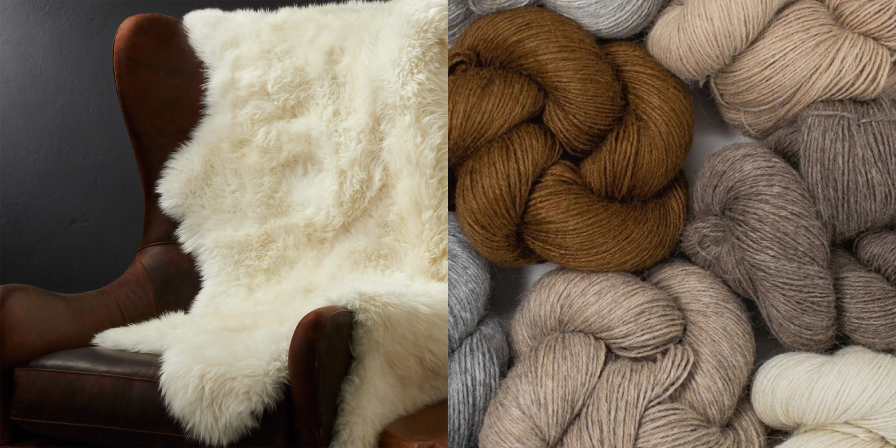
- MerinoMood
- News
- What is the difference between sheepskin and wool?
What is the difference between sheepskin and wool?
Share
 Natana Nikola
Natana Nikola
People often ask what is better: sheepskin or wool on a fabric base. We can answer with total confidence that in terms of comfort, heat retention, air exchange, and health benefits, natural sheepskin is the best choice. On the other hand, many people instead opt for sheep’s wool on a fabric base as sheepskin can be rather expensive due to its numerous benefits. The choice, as always, is up to the customer.
What does 100% sheepskin mean?

To simplify things, sheep’s wool on a fabric base is made from wool sheared from a sheep and then glued to a fabric base using special technologies, while natural sheepskin is the skin of a sheep that has reached the age of six months, removed with the wool intact. After the skin is removed, it undergoes certain stages of processing. Let's examine how these materials are obtained in more detail because the beneficial qualities depend on this.
Sheep’s wool on a fabric base is produced as follows: After a sheep is sheared, the wool is thoroughly washed and combed. Upon reaching the desired condition with the help of professional equipment, the wool is fixed on a fabric base (typically coarse calico, corduroy, suede, velour, or artificial leather) as if woven into it. Usually, the base is no more than 30 percent synthetic, but the proportions can vary. Such materials are classified as textiles, not fur, so they are characterized by a lower cost.
In contrast, the processing of natural sheepskin is much more complicated. It includes the following stages:
- Cleaning and preservation no later than two hours after removal to prevent bacterial growth and preserve the skin.
- Soaking to soften the skin and clean it more thoroughly.
- Fleshing to remove biological residues from the inside of the skin.
- Degreasing with solvents and surface-active agents (surfactants).
- Pickling, during which the skin is exposed to an acidic sodium chloride (common salt) solution. It breaks down collagen, softens the leather, and gives it elasticity.
- Tanning, which enhances durability and resistance to wear, moisture, and temperature fluctuations.
At the final stage, the skin is greased, pressed, dried, stretched, and polished. The edges are evenly trimmed; if necessary, the wool is also trimmed.

Only after passing through all these stages does sheepskin become finished sheepskin. This is the source material for producing sheepskin products, including women's clothing from natural sheepskin.
How to choose natural sheepskin: Classification and peculiarities
Classification of sheepskin is carried out at the raw-material stage. The types of sheepskin are differentiated based on such signs as:
- The age of the sheep. Most sheepskin is obtained from sheep older than 5–6 months.
- Breed features. More than 600 breeds of sheep are farmed for meat. Sheepskins are collected and recycled to make clothes, shoes, throw blankets, pillows, and accessories. Indoor shoes made of sheepskin are especially comfortable and practical to wear. For example, it is advisable to buy men's house slippers made of sheepskin, which will not only feel pleasant to wear but also provide a micro-massage for tired men's feet.
- The presence and number of defects.
- The purpose of the sheepskin, which directly depends on the type of fleece and the way it is processed.

The different varieties of sheepskin and how to distinguish sheepskin from wool
Depending on the purpose and type of fleece, sheepskin comes in the following types:
- Shearling. There are special requirements for the quality of the leather, since it is worn with the wool on the back side, and the leather backing on the front side. It is used to make shearling sheepskin coats, jackets, vests, and some types of shoes.
- Wool type. This is designed for sewing products with the wool on the outside, for example, in hats and mats. You can also buy sheepskin shoes for your baby to keep their feet dry and warm while they walk or crawl on the floor.
- Leather. Sheep leather is made from skins with wool less than 5 mm high. Options include lycra, suede, glazed kid leather, and haberdashery leather.

As for the difference between sheepskin and textile-based sheep’s wool products, it is difficult to distinguish them visually. To determine what the product is made of, you will need to move the wool aside and look at the base. In the case of genuine sheepskin, you will see skin; if it is wool with a fabric base, you’ll see a textile material.
Why is sheepskin so expensive?
Natural sheepskin has numerous advantages, which contribute to its price. Below, we will compare natural sheepskin’s benefits to textile-based sheep’s wool:
- 100% sheepskin is an entirely natural material. Wool with a fabric backing contains a certain percentage of synthetics in the fabric base.
- The durability of sheepskin is 4–5 years, while for wool with a fabric base, it is 1–1.5 years.
- Sheepskin absorbs moisture up to 35% of its own weight, while wool on a fabric base only absorbs up to 6%.
- Clothing made of sheepskin protects well from the cold, even in -20°C frost. Wool with a fabric backing protects to a maximum of -10°C. Therefore, when asked what is warmer - wool or sheepskin, the answer is the same: sheepskin is the warmest!
- Unlike fabric-based wool, sheepskin does not collect static electricity.

Regarding health benefits, sheepskin is a more favorable choice than wool products on a fabric backing. It perfectly regulates heat exchange, which eliminates both overcooling and overheating. In addition, it is hypoallergenic, while wool can cause allergic reactions. In general, sheepskin benefits outweigh those of wool with a fabric base, so the better choice is sheepskin.
